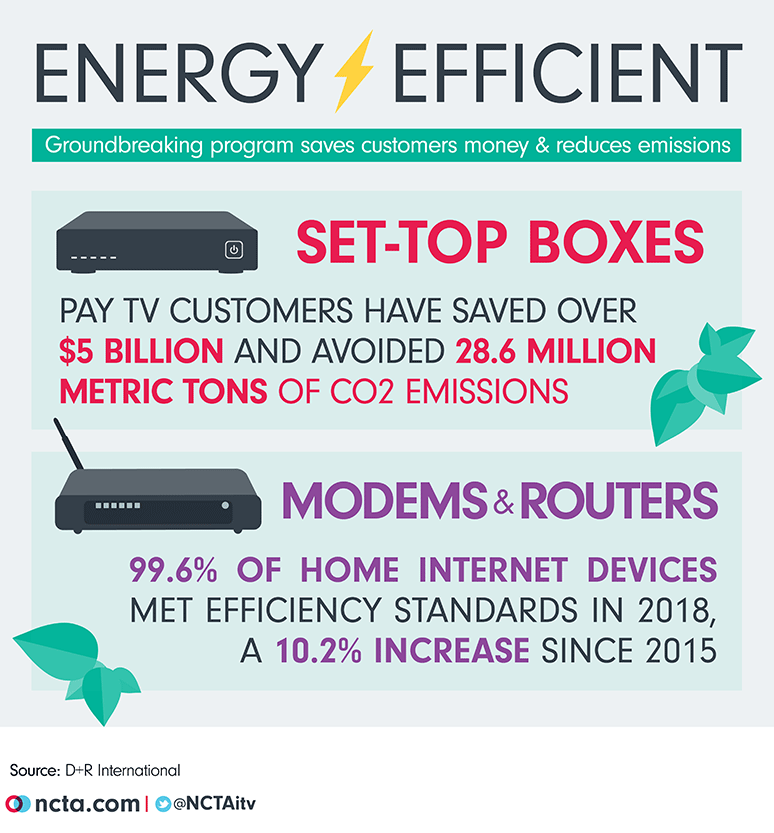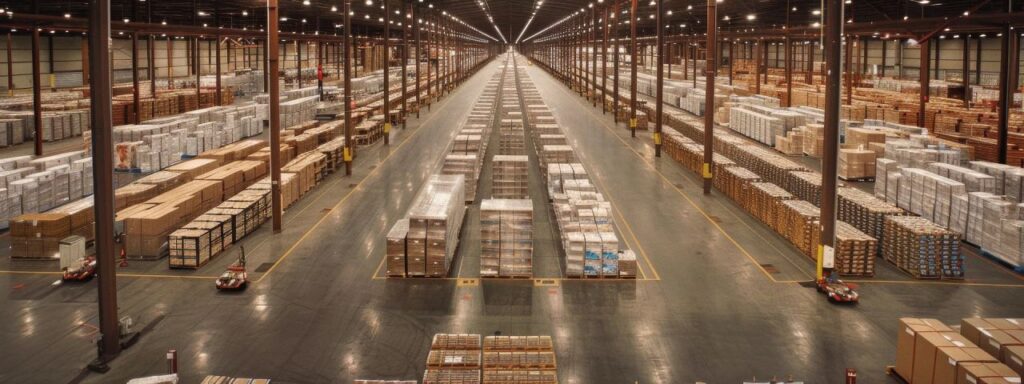Consumers have now saved more than $5 billion in electricity costs since 2013, thanks to two energy-efficiency “voluntary agreements” that are improving energy efficiency without compromising upgrades or enhancements to set-top boxes and home internet equipment. Under each of these agreements, service providers representing approximately 90% of the residential pay-TV and broadband internet markets in the U.S. committed that at least 90% of their new devices would meet the agreements’ energy-efficiency levels.
Last week, D+R International—the independent auditor for the agreements—released findings that demonstrate the significant progress that has been made by the industry on this front. All of the agreement signatories met their commitments under both agreements in 2018. More rigorous energy efficiency levels for both agreements become applicable in 2020, which are expected to result in even greater improvements to energy efficiency.
Set-Top Boxes
The Voluntary Agreement for Ongoing Improvement to the Energy Efficiency of Set-Top Boxes was signed in 2012 with the goal of increasing the energy efficiency of set-top boxes while continuing to innovate and introduce new features. Signatories include service providers Comcast, Charter, Cox, AT&T/DIRECTV, DISH, Altice, Verizon, Frontier, and CenturyLink, manufacturers ARRIS and Technicolor, and energy efficiency advocates the Natural Resources Defense Council and American Council for an Energy-Efficient Economy (ACEEE). The latest successes include:
- Set-top box users saved approximately $1.6 billion in energy costs in 2018 alone.
- The energy saved during the six years of the set-top box agreement would be enough to power all homes in the state of Pennsylvania with electricity for a year.
- More than 28.6 million metric tons of CO2 emissions were avoided over the past six years, which is the equivalent of the annual emission of more than six million typical cars.
- The total energy footprint of all set-top boxes nationwide in consumer homes has fallen by nearly 40%.
- The number of consumer-owned devices that accessed service provider video using apps on other devices instead of a set-top box increased by 33% in 2018.
According to Noah Horowitz, Senior Scientist at the Natural Resources Defense Council, the set-top box voluntary agreement “accelerated a nationwide shift to more energy efficient set-top boxes, and consumers and the environment are seeing big benefits.”
These savings are driven by several accomplishments of the voluntary agreement, including:
- A nearly 50% decline in the energy used by new DVRs.
- A reduction in the number of DVRs due to whole-home technologies that enable consumers to watch recorded content on multiple TVs using a single DVR.
- Apps that enable customers to watch the service providers’ video services without any operator-provided set-top box on Smart TVs, tablets, and streaming devices.
Small Network Equipment (SNE)
SNE includes broadband modems, routers, Wi-Fi extenders and other related equipment used by consumers for internet access. The Voluntary Agreement for Ongoing Improvement to the Energy Efficiency of Small Network Equipment adopted in 2015 outlines the steps for increasing energy efficiency in SNE. Signatories include most of the industry members of the set-top box agreement plus manufacturers of retail equipment such as Actiontec, Netgear, and Ubee. The latest results include:
- Nearly all (99.6%) of SNE purchased and sold in 2018 for use by U.S. residential broadband subscribers met the energy-efficiency standards in the agreement.
- Average idle mode energy usage of SNE relative to average broadband speed has decreased by 66% since the agreement was ratified in 2015.
- All signatories fulfilled their commitment that 90% of their new devices would meet the Agreement’s energy efficiency levels.
- These improvements were made while average broadband speeds have tripled since 2015.
To top it off, this Spring the SNE agreement for home internet equipment was named “Project of the Year” this spring by Environmental Leader, a leading daily trade publication covering energy, environmental, and sustainability news.
These achievements speak for themselves. While conventional energy efficiency regulation struggles to keep pace with new technologies, the voluntary agreements enable companies to make new features available to consumers immediately, and provide the flexibility needed to deploy innovative and improved services.
For more information on the energy efficiency voluntary agreements and a full list of signatories, go to https://www.energy-efficiency.us.









